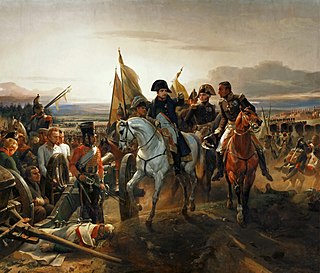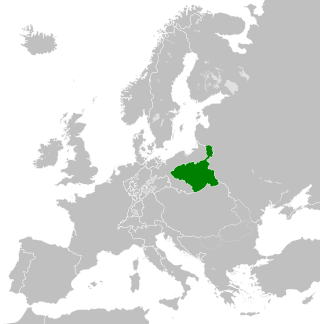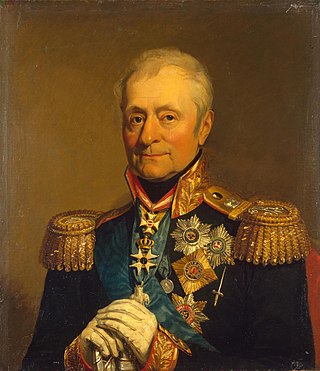
The Napoleonic Wars (1803–1815) were a series of conflicts fought between the First French Empire under Napoleon (1804–1815), and a fluctuating array of European coalitions. The wars originated in political forces arising from the French Revolution (1789–1799) and from the French Revolutionary Wars (1792–1802), and produced a period of French domination over Continental Europe. There were seven Napoleonic Wars, five named after the coalitions that fought Napoleon, plus two named for their respective theatres: (i) the War of the Third Coalition (1803–1806), (ii) the War of the Fourth Coalition (1806–1807), (iii) the War of the Fifth Coalition (1809), (iv) the War of the Sixth Coalition (1813–1814), (v) the War of the Seventh Coalition (1815), (vi) the Peninsular War (1807–1814), and (vii) the French invasion of Russia (1812).

The Battle of Borodino took place near the village of Borodino on 7 September [O.S. 26 August] 1812 during Napoleon's invasion of Russia. The Grande Armée won the battle against the Imperial Russian Army, but failed to gain a decisive victory and suffered tremendous losses. Napoleon fought against General Mikhail Kutuzov, whom the Emperor Alexander I of Russia had appointed to replace Barclay de Tolly on 29 August [O.S. 17 August] 1812 after the Battle of Smolensk. After the Battle of Borodino, Napoleon remained on the battlefield with his army; the Imperial Russian forces retreated in an orderly fashion southwards. Because the Imperial Russian army had severely weakened the Grande Armée, they allowed the French occupation of Moscow, using the city as bait to trap Napoleon and his men. The failure of the Grande Armée to completely destroy the Imperial Russian army, in particular Napoleon's reluctance to deploy his Imperial Guard, has been widely criticised by historians as a huge blunder, as it allowed the Imperial Russian army to continue its retreat into territory increasingly hostile to the French. Approximately a quarter of a million soldiers were involved in the battle, and it was the bloodiest single day of the Napoleonic Wars.

The Battle of Eylau, or Battle of Preussisch-Eylau, was a bloody and strategically inconclusive battle on 7 and 8 February 1807 between Napoleon's Grande Armée and the Imperial Russian Army under the command of Levin August von Bennigsen near the town of Preussisch Eylau in East Prussia. Late in the battle, the Russians received timely reinforcements from a Prussian division of von L'Estocq. After 1945, the town was renamed Bagrationovsk as part of Kaliningrad Oblast, Russia. The engagement was fought during the War of the Fourth Coalition, part of the Napoleonic Wars.

The Battle of Friedland was a major engagement of the Napoleonic Wars between the armies of the French Empire commanded by Napoleon I and the armies of the Russian Empire led by Count von Bennigsen. Napoleon and the French obtained a decisive victory that routed much of the Russian army, which retreated chaotically over the Alle River by the end of the fighting. The battlefield is located in modern-day Kaliningrad Oblast, near the town of Pravdinsk, Russia.

The Duchy of Warsaw, also known as the Grand Duchy of Warsaw and Napoleonic Poland, was a French client state established by Napoleon Bonaparte in 1807, during the Napoleonic Wars. It initially comprised the ethnically Polish lands ceded to France by Prussia under the terms of the Treaties of Tilsit, and was augmented in 1809 with territory ceded by Austria in the Treaty of Schönbrunn. It was the first attempt to re-establish Poland as a sovereign state after the 18th-century partitions and covered the central and southeastern parts of present-day Poland.

The War of the Second Coalition was the second war on revolutionary France by most of the European monarchies, led by Britain, Austria, and Russia and including the Ottoman Empire, Portugal, Naples and various German monarchies. Prussia did not join the coalition, and Spain supported France.

Levin August Gottlieb Theophil, Grafvon Bennigsen was a German general in the service of the Russian Empire. Bennigsen is immortalized in Russian history as the man who fought Napoleon Bonaparte with distinction at the Battle of Preussisch Eylau and played a pivotal role in decisively defeating Napoleon in the War of the Sixth Coalition.

The War of the Fourth Coalition was a war spanning 1806-1807 that saw a multinational coalition fight against Napoleon's French Empire and were defeated. The main coalition partners were Prussia and Russia with Saxony, Sweden, and Great Britain also contributing. Excluding Prussia, some members of the coalition had previously been fighting France as part of the Third Coalition, and there was no intervening period of general peace. On 9 October 1806, Prussia declared war on France and joined a renewed coalition, fearing the rise in French power after the defeat of Austria and establishment of the French-sponsored Confederation of the Rhine in addition to having learned of French plans to cede Prussian-desired Hanover to Britain in exchange for peace. Prussia and Russia mobilized for a fresh campaign with Prussia massing troops in Saxony.

The Battle of Heilsberg took place on 10 June 1807, during the Napoleonic Wars.

The Second Battle of the Somme of 1918 was fought during the First World War on the Western Front from late August to early September, in the basin of the River Somme. It was part of a series of successful counter-offensives in response to the German Spring Offensive, after a pause for redeployment and supply.

The siege of Danzig was the French encirclement and capture of Danzig during the War of the Fourth Coalition. On 19 March 1807, around 27,000 French troops under Marshal Lefebvre besieged around 14,400 Prussian troops under Marshal Kalckreuth garrisoning the city of Danzig.

The battle of Sourton Down was a successful Parliamentarian ambush at Sourton Down, in South West England, on 25 April 1643, during the First English Civil War. After a failed attack on Royalist-held Launceston, the Parliamentarians fell back to their base at Okehampton, pursued by a Royalist army under Sir Ralph Hopton, who marched overnight, planning to attack the town at dawn.

Jean-Joseph Ange d'Hautpoul was a French cavalry general of the Napoleonic Wars. He came from an old noble family of France whose military tradition extended for several centuries.

Pierre Belon Lapisse, Baron de Sainte-Hélène commanded an infantry division in Napoleon's armies and was fatally wounded fighting against the British in the Peninsular War. He enlisted in the French Army during the reign of Louis XVI and fought in the American Revolutionary War. Appointed an officer at the start of the French Revolutionary Wars, he rose in rank to become a general officer by 1799. From 1805 to 1807 during the Napoleonic Wars, he led a brigade in the Grande Armée at Dornbirn, Jena, Kołoząb, Golymin, and Eylau. After promotion he commanded a division in the thick of the action at Friedland in 1807.

The First French Empire, officially the French Republic, then the French Empire after 1809 and also known as Napoleonic France, was the empire ruled by Napoleon Bonaparte, who established French hegemony over much of continental Europe at the beginning of the 19th century. It lasted from 18 May 1804 to 3 May 1814 and again briefly from 20 March 1815 to 7 July 1815.

Frédéric Bey, born 20 April 1961 at Issy-les-Moulineaux in France, is a designer of wargames and the author of books and articles on the subject of military history.

In the Battle of Guttstadt-Deppen on 5 and 6 June 1807, troops of the Russian Empire led by General Levin August, Count von Bennigsen attacked the First French Empire corps of Marshal Michel Ney. The Russians pressed back their opponents in an action that saw Ney fight a brilliant rearguard action with his heavily outnumbered forces. During the 6th, Ney successfully disengaged his troops and pulled back to the west side of the Pasłęka (Passarge) River. The action occurred during the War of the Fourth Coalition, part of the Napoleonic Wars. Dobre Miasto (Guttstadt) is on Route 51 about 20 kilometers (12 mi) southwest of Lidzbark Warmiński (Heilsberg) and 24 kilometers (15 mi) north of Olsztyn (Allenstein). The fighting occurred along Route 580 which runs southwest from Guttstadt to Kalisty (Deppen) on the Pasłęka.
Alexander Mikaberidze is a Georgian lawyer, author and historian who specializes in Napoleonic studies. He is a full professor of history and social sciences at Louisiana State University in Shreveport, where he holds the Ruth Herring Noel Endowed Chair for the Curatorship of the James Smith Noel Collection, one of the largest private collections of antiquarian books, prints, and maps in the United States.

The British Baltic Fleet and also known as the Baltic Squadron was a series of temporary or semi permanent fleets of the Royal Navy. They were assembled at Spithead a naval anchorage in the English Channel for various naval operations in the Baltic Sea from 1658 to 1856 commanded by the Commander-in-Chief, Baltic Fleet.

Friedland 1807 is a board wargame published by Imperial Games in 1974 that simulates the pivotal Battle of Friedland that pitted Russian forces against those of Napoleon I.



















